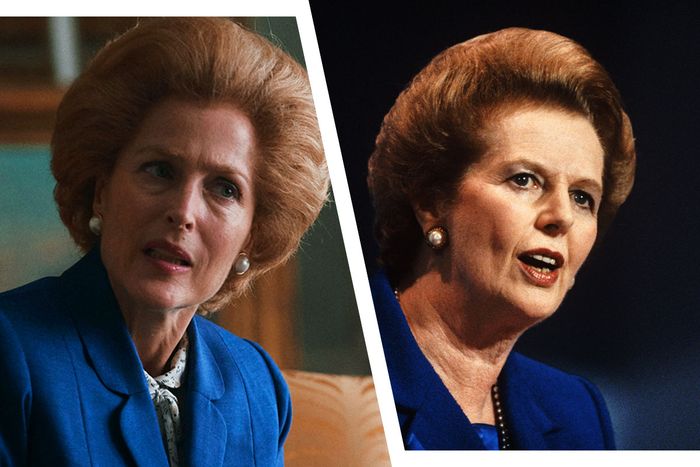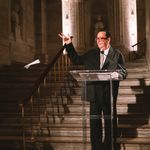
The new season of The Crown sees Olivia Colman’s Elizabeth II receding from the spotlight to make way for two iconic figures of the 1980s. American viewers are likely very familiar with the story of Princess Diana, but they may be more at sea when it comes to the series’s other new face: Gillian Anderson’s Margaret Thatcher. The series gives us the broad strokes — first female prime minister, same age as the queen, big hair, archconservative. And that’s usually enough! But for those who want to dig a little deeper, please enjoy this supplemental reading on all things Margaret Thatcher. (For best results, refer to her solely by surname, preferably accompanied by a sneer, rolled eyes, or both.)
First things first: Did she really talk like that?
Gillian Anderson’s over-the-top accent work in The Crown is probably the most contentious element of her performance; as my friends Joe Reid and Chris Feil say, the voice is the choice. To me, she hasn’t quite gotten it. In the collection of video clips below, you can hear how the real Thatcher had a lightness to her voice, a soft musical lilt, which Anderson’s version lacks. (This lightness was not natural; she adopted it at the suggestion of her image consultant.) However, I’ve noticed that those who lived through the Thatcher era are more convinced of its accuracy. Could it be that Anderson’s heavier, more ominous intonation is giving us not the way Thatcher actually spoke, but the way her voice was perceived by those who hated her?
Let’s talk about the hatred. The Crown makes clear that Thatcher was hated because of her policies. But what exactly were those policies?
I have to credit The Crown for doing something I didn’t expect, devoting an entire episode to the oppressive shittiness of Britain in the ’80s. But as the series also has to make space for the decade’s most torrid love triangle, it understandably doesn’t get too far into the political weeds. As summed up by her ally Nigel Lawson (yes, Nigella’s dad), Thatcherism stood for “free markets, financial discipline, firm control over public expenditure, tax cuts, nationalism, ‘Victorian values’ … privatization and a dash of populism.” Subsidized industries were cut off. Unions were crushed. Anything that could be put up for sale was. Still, what The Crown understands is that the substance of her government was sometimes less important than the style. As Tony Judt puts it in Postwar, “Thatcherism was about how you govern, rather than what you do.” The series capably gets across her cold, unyielding rule, which contributed as much as any of her policies to the rage she induced in those who opposed her.
One aspect of the era The Crown doesn’t mention is that, in the middle of the decade, the U.K.’s economy did indeed turn around, and though the growth was not equally shared, inflation was tamed, and thanks to the government’s Right to Buy scheme (the rare Thatcherite policy that was widely popular) more people were able to own a home. However, as Judt writes, “As an economy … Thatcherized Britain was a more efficient place. But as a society it suffered meltdown, with catastrophic long-term consequences.” As we see in The Crown, unemployment skyrocketed; at its peak in 1984, more than twice as many were out of work as five years earlier. Income inequality rose, too, as did crime. If you were one of those shut out of the boom times — if you lived in the north, say, or worked in manufacturing — you experienced her reign as a period of ever-increasing precarity.
The attendant loss of civic trust and social cohesion was no less real for being unquantifiable. Even the conservative historian Robert Tombs is clear about what was lost in the transformation: “Much indeed disappeared during the 1970s and 1980s: a patriarchal working-class society, neighborly communities, chapel-going … family stability, self-respect. Whole landscapes — the Victorian landscape of textile mills, tall chimneys, docks, pitheads, shipyards, and terraced houses — were obliterated.” In their place was the Britain of today.
Got it. Let’s get more specific. Did she actually have a tense relationship with the royals?
The Windsors would never admit as much, but The Crown’s portrait of the icy relationship between the head of government and the head of state is based on a widely accepted narrative. In public Thatcher always backed the monarchy as a symbol of patriotism, but those who read between the lines couldn’t help noticing some tension. As Alwyn Turner writes in Rejoice! Rejoice!, for Thatcher the royal family might have seemed “everything she stood against … the ultimate monopoly, the most exclusive closed shop of all.” The Conservatives had always been a coalition of the aristocracy and the petite bourgeoisie, but her government represented the ultimate triumph of the latter over the former. It was marked by conflict against the Establishment on all fronts — not just manor-born Tories and cultural elites, but also the civil service and the Church of England. Per Judt, the prime minister had no interest in “the longstanding British tradition of governing from as close to the political center as possible,” surely a distressing prospect for the woman who was the physical embodiment of long-standing British tradition.
Most of what you see in the episode “48:1” is grounded in the circumstantial evidence available to us: The Sunday Times really did run a story suggesting that the queen was disturbed by Thatcher’s “confrontational and socially divisive” politics and refusal to sign onto sanctions against apartheid South Africa. Buckingham Palace and Downing Street both denied it, and the press aide who was the paper’s source really did resign and become an author of political thrillers. How much a role the queen actually played in this affair will probably never be known, and for what it’s worth, the aide claimed until the very end that he had been misquoted. But he would say that, wouldn’t he?
An earlier episode, “The Balmoral Test,” takes slightly more liberties. According to Sally Bedell Smith’s biography of Elizabeth, while visiting the queen in Scotland Thatcher “invariably arrived in a tweed suit and heels, utterly unprepared for country life,” but I’m with Tom and Lorenzo that “this seems more like her patented Thatcher stubbornness than an uncharacteristic ignorance about what was expected of her.” Smith also notes that, rather than spending the weekend humiliating her guest, the queen rearranged elements of the traditional festivities to accommodate Thatcher’s preferences, throwing a “barbecue” rather than a “dinner” so that the prime minister would not have to withdraw with the other ladies in attendance afterward.
What about the Falklands? Was she really spurred to action by her son’s disappearance in the Sahara Desert?
Probably not. The show fiddles with the timeline a bit: Mark Thatcher was lost and found in January 1982, while the Falklands crisis didn’t kick off until later in the spring. That’s to be expected; this is The Crown we’re talking about, where the political is always personal.
Anyway, one doubts Thatcher would have needed a Freudian excuse to go to war for the islands. Having been elected, in her mind, to reverse the narrative of Britain’s postwar decline, she staked substantial political capital on defending the sparsely populated, sheep-strewn archipelago. While other members of her party feared becoming embroiled in a South Atlantic quagmire, she leapt into the conflict with self-consciously Churchillian gusto. “Anything less than total military victory would surely have ended Thatcher’s premiership, so totally had she identified herself with the war,” notes Turner. But it was a victory, and thus, “what had previously been seen as terrible political faults — her stubbornness in following her own course, her refusal to listen to other points of view — were now magically transformed into the greatest of her virtues.”
As the victory celebrations we see in “Fagan” indicate, Thatcher’s popularity was never higher than immediately following the war, when she enjoyed a 59 percent approval rating, which was otherwise underwater for much of her time at Downing Street. (It also rose in 1984, when Thatcher narrowly escaped being blown up by the IRA, an incident the show neglects to include.)
If she was so unpopular, how did she stay in office for 11 years?
Great question! Besides the Falklands effect, a sizable portion of the blame must go to the haplessness of the opposition; Judt writes that Thatcher “did not so much win elections as watch Labour lose them.” After the Conservatives’ victory in the 1979 general election, Labour splintered. A squad of centrist MPs broke off to form the Social Democratic Party, eventually merging with the Liberals from A Very English Scandal to create today’s irrelevant third party, the Lib Dems. Having witnessed the debacle of the vacillating late-’70s Labour government, those who remained in the fold found refuge in ideological purity. It was a disaster. Labour’s 1983 manifesto was famously dubbed “the longest suicide note in history,” and the anti-Thatcher vote now having been split, they were wiped out in the subsequent election.
In the years that followed, Labour moderates would attempt to purge the party of its more militant tendencies — often literally. But the reliance on unpopular or outdated ideas mixed with incessant infighting gave Labour an aura of impotence it would not shake for more than a decade, best summed up by the Spitting Image segment “We’re Useless”:
Thatcher’s unpopularity has also been magnified by the fact that so many of her detractors worked in media and the arts, which of course play an outsize role in determining her legacy. But her supporters were not limited to Essex day traders and Murdoch acolytes. Turner quotes the DJ Jazzie B of the music collective Soul II Soul, who had benefited from the government’s small-business grants to the unemployed: “For me, Margaret Thatcher was quite important, because she helped legitimize exactly what we were doing. Her whole ethos was about you being more enterprising and getting on with it.”
Why did she finally get the sack?
The events leading to Thatcher’s ouster in 1990 mostly played out the way they did in the season finale: Her Foreign Minister Geoffrey Howe’s resignation speech in the House of Commons spurred an uprising against her in her own party, and though she technically won the first round of voting in the leadership challenge that followed, the margins were slim enough that she was convinced to resign.
Why did the backbenchers revolt? Part of it was the economy, which had crashed again in 1987. Part of it was the government’s deeply unpopular plan to introduce a flat “poll tax,” which amounted to a drastic tax increase on society’s poorest, and ignited some of the fiercest protests of the era. And part of it was her disagreements with her ministers over how much Britain should engage economically with the rest of Europe — which, spoiler alert, would come up again later. And, after more than a decade at Downing Street, she simply had no allies left. As Judt sums up, she “had led her party to three successive general election victories and governed virtually alone for nearly twelve years. But that of course is the point: Margaret Thatcher governed alone.”





